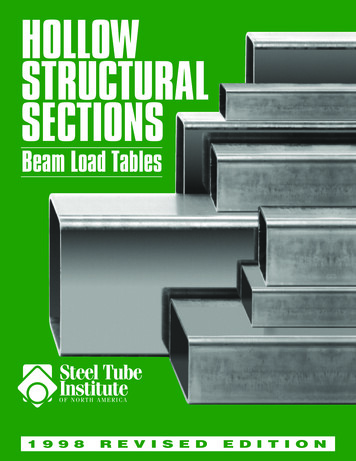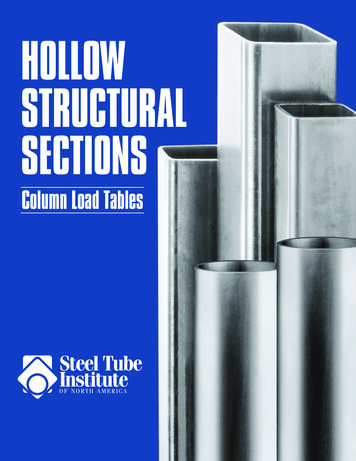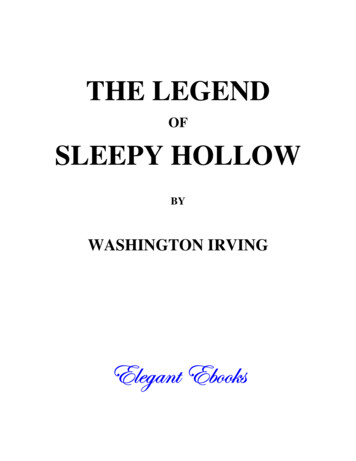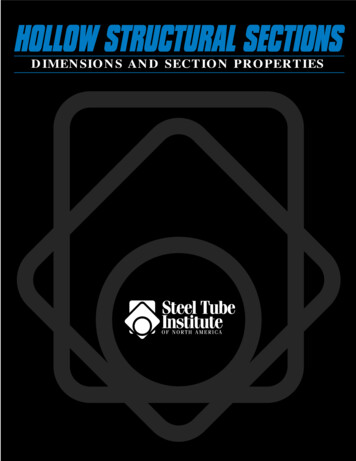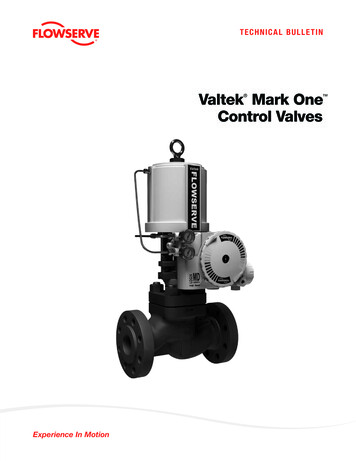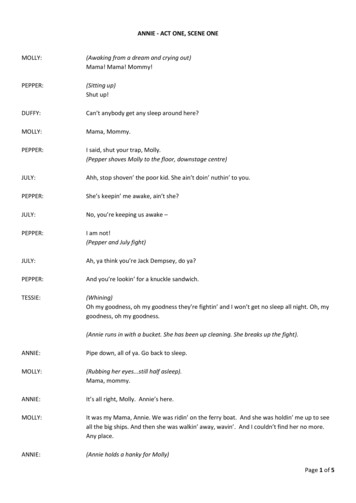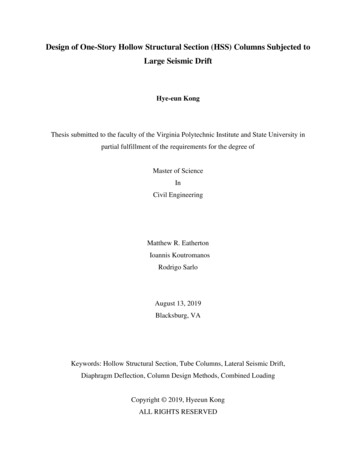
Transcription
Design of One-Story Hollow Structural Section (HSS) Columns Subjected toLarge Seismic DriftHye-eun KongThesis submitted to the faculty of the Virginia Polytechnic Institute and State University inpartial fulfillment of the requirements for the degree ofMaster of ScienceInCivil EngineeringMatthew R. EathertonIoannis KoutromanosRodrigo SarloAugust 13, 2019Blacksburg, VAKeywords: Hollow Structural Section, Tube Columns, Lateral Seismic Drift,Diaphragm Deflection, Column Design Methods, Combined LoadingCopyright 2019, Hyeeun KongALL RIGHTS RESERVED
Design of One-Story Hollow Structural Section (HSS) Columns Subjected toLarge Seismic DriftHye-eun KongACADEMIC ABSTRACTDuring an earthquake, columns in a one-story building must support vertical gravity loadswhile undergoing large lateral drifts associated with deflections of the vertical seismic forceresisting system and deflections of the flexible roof diaphragm.Analyzing the behavior of thesegravity columns is complex since not only is there an interaction between compression andbending, but also the boundary conditions are not perfectly pinned or fixed.In this research, thebehavior of steel columns that are square hollow structural sections (HSS) is investigated forstability using three design methods: elastic design, plastic hinge design, and pinned base design.First, for elastic design, the compression and flexural strength of the HSS columns are calculatedaccording to the AISC specifications, and the story drift ratio that causes the interaction equationto be violated for varying axial force demands is examined.Then, a simplified design procedureis proposed; this procedure includes a modified interaction equation applicable to HSS columndesign based on a parameter, Pnh/Mn, and a set of design charts are provided. Second, a plastichinge design is grounded in the concept that a stable plastic hinge makes the column continue toresist the gravity load while undergoing large drifts. Based on the available test data and theanalytical results from finite element models, three limits on the width to thickness ratios aredeveloped for steel square HSS columns.Lastly, for pinned base design, the detailing of acolumn base connection is schematically described.Using FE modeling, it is shown that it ispossible to create rotational stiffness below a limit such that negligible moment develops at thecolumn base.All the design methods are demonstrated with a design example.
GENERAL AUDIENCE ABSTRACTOne-story buildings are one of the most economical types of structures built for industrial,commercial, or recreational use.During an earthquake, columns in a one-story building mustsupport vertical gravity loads while undergoing large lateral displacements, referred to as storydrift.Vertical loads cause compression forces, and lateral drifts produce bending moments.The interaction between these forces makes it more complex to analyze the behavior of thesegravity columns. Moreover, since the column base is not perfectly fixed to the ground, there aremany boundary conditions applicable to the column base depending on the fixity condition.Forthese reasons, the design for columns subjected to lateral drifts while supporting axial compressiveforces has been a growing interest of researchers in the field.However, many researchers havefocused more on wide-flange section (I-shape) steel columns rather than on tube section columns,known as hollow structural section (HSS) steel columns.In this research, the behavior of steel square tube section columns is investigated for stabilityusing three design methods: elastic design, plastic hinge design, and pinned base design.First,for elastic design, the compression and flexural strength of the HSS columns are calculatedaccording to current code equations, and the story drift that causes failure for varying axial forcedemands is examined.Then, a simplified design procedure is proposed including design charts.Second, a plastic hinge design is grounded in the concept that controlled yielding at the columnbase makes the column continue to resist the gravity load while undergoing large drifts.Basedon the available test data and results from computational models, three limits on the width tothickness ratios of the tubes are developed.Lastly, for pinned base design, concepts for detailinga column base connection with negligible bending resistance is schematically described.Usinga computational model, it is shown that the column base can be detailed to be sufficiently flexibleto allow rotation.All the design methods are demonstrated with a design example.
ACKNOWLEDGEMENTSThis work was part of the Steel Diaphragm Innovation Initiative (SDII) which is funded byAISI, AISC, SDI, SJI, and MBMA and is part of the Cold-Formed Steel Research Consortium(CFSRC).The author acknowledges Advanced Research Computing at Virginia Tech forproviding computational resources and technical support that have contributed to the resultsreported within this thesis paper. URL: http://www.arc.vt.edu.I would like to express my deepest gratitude to my advisor Dr. Matthew R. Eatherton for hisinvaluable guidance throughout my research. His dedication to this research encouraged me tobe an academic researcher. It is a great honor to work with him throughout my master’s degree.I would also like to thank to Dr. Koutromanos and Dr. Sarlo, for being a part of my committeemembers and giving me feedbacks related to this research.I would like to extend my gratitudetoward Dr. Benjamin W. Schaffer for his expertise and collaboration.Last but not least, I would also like to express special thanks to my family for theirunconditional love and support through my life and education.possible without their continuous encouragement.ivThis work would not have been
TABLE OF CONTENTSACADEMIC ABSTRACT . iiGENERAL AUDIENCE ABSTRACT . iiiACKNOWLEDGEMENTS . ivTABLE OF CONTENTS . vLIST OF FIGURES . viiiLIST OF TABLES. xiiLIST OF VARIABLES . xiii1. INTRODUCTION. 11.1. Background . 11.2. Research Motivation . 21.3. Objective and Scope of Research . 31.4. Thesis Organization . 42. LITERATURE REVIEW . 62.1. Story Drifts in One-Story Buildings . 62.2. Designing for Diaphragm Deflection. 72.3. Evaluating Fixity at Column Base . 92.4. Elastic Design for Fixed-Base Columns . 102.5. Plastic Hinge Design for Fixed-Base Columns . 122.5.1.W-Shape . 122.5.2.Tube . 132.5.3.Slenderness Limit for Stable Plastic Hinge Formation in W-Shape . 142.5.4.Literature that may support Slenderness Limit for Tube . 163. ELASTIC DESIGN. 183.1. Evaluation of Column Stability . 183.1.1.Axial Compression Strength, Pn . 183.1.2Flexural Strength, Mn . 203.1.3Axial-Bending Interaction . 213.2. Parameters to Vary and Alternative Interaction Equation . 21v
3.3. Proposed Design Procedure . 233.3.1.Example Plots for Six Representative Hollow Square Sections. 233.3.2.Key Design Parameter, 𝑃𝑛ℎ/𝑀𝑛 . 253.3.3Developed a Simple Design Procedure . 254. PLASTIC DESIGN . 294.1. Proposed HSS Slenderness Limit Based on the Literature . 294.2. Finite Element Modeling . 314.2.1.Model Validation . 314.2.2.Loading Schemes . 344.2.3Material Validation . 354.2.4Mesh Sensitivity . 374.2.5Validation Results. 394.3. Parametric Study . 444.3.1.Numerical Modeling . 444.3.2.Multivariate Regression Analysis . 634.3.3 Critical Axial Load Ratio (CALR) . 724.4 Developed Highly Ductile Slenderness Limits for HSS Columns . 744.4.1 Comparison of Highly Ductile Slenderness Limits . 744.4.2 Evaluation of Regression Equations . 755. PINNED-BASE DESIGN . 776. DESIGN EXAMPLE . 806.1. Prototype Building . 806.2. Drift Calculation . 836.3. Required Axial Strength Calculation . 866.4. Design Method 1: Elastic Design . 866.5. Design Method 2: Plastic Hinge Design . 876.6. Design Method 3: Pinned Base Design . 876.7. Discussion . 887. CONCLUSIONS . 897.1 Elastic Design Method . 89vi
7.2 Plastic Hinge Design Method . 907.3 Pinned-base Design Method . 917.4 Recommendations for Future Work . 91REFERENCES. 94APPENDIX A. Moment-Drift Rotation Curves for Parametric Studies . 98APPENDIX B. Axial Shortening Ratio-Drift Rotation Curves for Parametric Studies. 123APPENDIX C. Multivariate Regression Results . 148vii
LIST OF FIGURESFigure 1-1. Typical column base condition . 1Figure 1-2. Typical column detailing and fixity . 2Figure 2-1. Typical one-story steel building . 6Figure 2-2. Drifts along the diaphragm span . 6Figure 2-3. Classification of moment -rotation response. 9Figure 3-1. Determination of axial compression strength . 19Figure 3-2. Determination of flexural strength . 20Figure 3-3. Idealized column boundaries and story drifts . 22Figure 3-4. Evaluating maximum allowable lateral drift for six example tube column sections . 24Figure 3-5. The plots of HSS column behavior based on 𝑃𝑛ℎ/𝑀𝑛 . 26Figure 3-6. The design charts of HSS columns . 28Figure 4-1. Comparison of slenderness limits . 31Figure 4-2. Finite element model showing boundary conditions . 33Figure 4-3. Drift loading protocols; (a) Experimental test data, (b) Drift rotation . 34Figure 4-4. The lateral displacement of each specimen for the FE analysis . 35Figure 4-5. The stress-strain relationship of the 0.1% bilinear kinematic hardening material . 36Figure 4-6. Comparison of moment-rotation relationships depending on the slope of plastic regionin the material stress-strain curve for the S-2201 specimen . 36Figure 4-7. The effect of mesh size on the moment-rotation behavior for; (a)S-2201 and (b)S-2203. 37Figure 4-8. Comparison of the mesh sensitiveness for S-2201 . 38Figure 4-9. Validation results for six specimens . 40Figure 4-10. Progressive buckling behaviors for S-2203 specimen . 43Figure 4-11. Selected section parameters . 47Figure 4-12. Boundary conditions and mesh arrangements. 47Figure 4-13. Cyclic loading sequence with lateral displacement . 48Figure 4-14. Procedure of defining 10% moment reduction criteria . 51Figure 4-15. 10% moment reduction criteria (ex. HSS12x12x3/4 with L 3.05m(10ft) whenP/Py 0.9) . 52Figure 4-16. Procedure of defining 0.25% axial shortening criteria. 53viii
Figure 4-17. 0.25% axial shortening criteria . 53Figure 4-18. Example of the drift capacity from elastic deformation . 54Figure 4-19. Types of failure modes: (a) Local buckling (LB) . 55Figure 4-20. Plots of local slenderness ratio (b/t) versus observed drift capacity . 64Figure 4-21. Plots of global slenderness ratio versus observed drift capacity . 64Figure 4-22. Plots of axial load ratio versus observed drift capacity . 65Figure 4-23. Plots of combination of slenderness ratio versus observed drift capacity . 65Figure 4-24. Scatter plots of the measured response versus the predicted response for Model 5 70Figure 4-25. Scatter plots of the measured response versus the predicted response for Model 12. 71Figure 4-26. CALR of Eq. (4-16) and expected CALR for columns given in Table 4-7 . 73Figure 4-27. CALR of Eq. (4-17) and expected CALR for columns given in Table 4-7 . 73Figure 4-28. Comparison of slenderness limits when E 29000ksi, Fy 50ksi, and L/ry 80. 75Figure 4-29. Plot of developed highly ductile slenderness limits for 15ft long HSS6x6x1/4 column. 76Figure 4-30. Drift capacity determined by two failure criteria for 15ft long HSS6x6x1/4 column76Figure 5-1. Possible detailing for pinned base . 77Figure 5-2. Deformed thin base plate attached to a 30ft-tall HSS8x8x3/8 section column . 78Figure 5-3. Moment-rotation curves of 30ft-tall HSS8x8x3/8 section columns . 79Figure 6-1. Plan view of the prototype building . 80Figure 6-2. Diaphragm shear distribution in north/south direction . 82Figure 6-3. North/south nailing zone layout . 83Figure 6-4. Moment-rotation curve of HSS8x8x3/8 30ft column . 88Figure 7-1. Axial shortening versus drift rotation curves . 92Figure 7-2. Moment-rotation curve for 15ft tall HSS4x4x1/8 columns when P/Py 0.75 . 93Figure A- 1. Moment-rotation curve for 10ft long HSS4x4x1/8 column . 98Figure A- 2. Mome
known as hollow structural section (HSS) steel columns. In this research, the behavior of steel square tube section columns is investigated for stability using three design methods: elastic design, plastic hinge design, and pinned base design. First, for elastic design, the compression and flexural st

